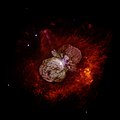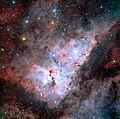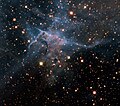This is an old revision of this page, as edited by Moonraker12 (talk | contribs) at 22:59, 12 June 2013 (Undo edits by Arianewiki1, yet again: So now you are edit warring to get your own way? This edit is wrong, per WP:LEAD. If you don’t like the title, take it to WP:RM). The present address (URL) is a permanent link to this revision, which may differ significantly from the current revision.
Revision as of 22:59, 12 June 2013 by Moonraker12 (talk | contribs) (Undo edits by Arianewiki1, yet again: So now you are edit warring to get your own way? This edit is wrong, per WP:LEAD. If you don’t like the title, take it to WP:RM)(diff) ← Previous revision | Latest revision (diff) | Newer revision → (diff)| Emission nebula | |
|---|---|
 An image of NGC 3372 taken by the ESO VLT telescope An image of NGC 3372 taken by the ESO VLT telescope | |
| Observation data: J2000.0 epoch | |
| Right ascension | 10 45 08.5 |
| Declination | −59° 52′ 04″ |
| Distance | ~6500-10000 ly ly |
| Apparent magnitude (V) | +1.0 |
| Constellation | Carina |
| Physical characteristics | |
| Radius | ~10 pc ly |
| Absolute magnitude (V) | ~10.8 |
| Notable features | Includes dark nebula Keyhole Nebula |
| Designations | NGC 3372, ESO 128-EN013, GC 2197, Caldwell 92 |
| See also: Lists of nebulae | |
The Carina Nebula (also known as the Great Nebula in Carina, the Eta Carina Nebula, NGC 3372, or Caldwell 92, as well as the Grand Nebula) is a large bright nebula that has within its boundaries several related open clusters of stars. Eta Carinae and HD 93129A, two of the most massive and luminous stars in our Milky Way galaxy, are among them. The nebula lies at an estimated distance between 6,500 and 10,000 light years from Earth. It appears in the constellation of Carina, and is located in the Carina–Sagittarius Arm. The nebula contains multiple O-type stars.
The nebula is one of the largest diffuse nebulae in our skies. Although it is some four times as large and even brighter than the famous Orion Nebula, the Carina Nebula is much less well known, due to its location in the southern sky. It was discovered by Nicolas Louis de Lacaille in 1751–52 from the Cape of Good Hope.
Objects within the Carina Nebula
Eta Carinae
Main article: Eta Carinae
Eta Carinae is a highly luminous hypergiant star. Estimates of its mass range from 100 to 150 times the mass of the Sun, and its luminosity is about four million times that of the Sun.
This object is currently the most massive star that can be studied in great detail, because of its location and size. Several other known stars may be more luminous and more massive, but data on them is far less robust. (Caveat: Since examples such as the Pistol Star have been demoted by improved data, one should be skeptical of most available lists of "most massive stars." In 2006, Eta Carinae still had the highest confirmed luminosity, based on data across a broad range of wavelengths.) Stars with more than 80 times the mass of the Sun produce more than a million times as much light as the Sun. They are quite rare—only a few dozen in a galaxy as big as ours—and they flirt with disaster near the Eddington limit, i.e., the outward pressure of their radiation is almost strong enough to counteract gravity. Stars that are more than 120 solar masses exceed the theoretical Eddington limit, and their gravity is barely strong enough to hold in its radiation and gas, resulting in a possible supernova or hypernova in the near future.
Eta Carinae's effects on the nebula can be seen directly. The dark globules in the above image and some other less visible objects have tails pointing directly away from the massive star. The entire nebula would have looked very different before the Great Eruption in the 1840s surrounded Eta Carinae with dust, drastically reducing the amount of ultraviolet light it put into the nebula.
Homunculus Nebula
Within the large bright nebula is a much smaller feature, immediately surrounding Eta Carinae itself. This small nebula is known as the Homunculus Nebula (from the Latin meaning Little Man), and is believed to have been ejected in an enormous outburst in 1841 which briefly made Eta Carinae the second-brightest star in the sky.
Keyhole Nebula
A portion of the Carina Nebula is known as the Keyhole Nebula, a name given to it by John Herschel in the 19th century. The Keyhole Nebula is actually a much smaller and darker cloud of cold molecules and dust, containing bright filaments of hot, fluorescing gas, silhouetted against the much brighter background nebula. The diameter of the Keyhole structure is approximately 7 light years. NGC 3324 is a designation for the Keyhole Nebula.
Mystic Mountain
Main article: Mystic MountainThe "Mystic Mountain" is an image of a dust–gas pillar in the Carina Nebula taken by Hubble Space Telescope on its 20th anniversary. The area was observed by Hubble’s Wide Field Camera 3 on February 1–2, 2010. The pillar measures three light years in height; nascent stars inside the pillar fire off gas jets, that stream from towering peaks.
Gallery
Tour of the Carina Nebula.Carina Nebula.This video starts from a wide-field view of the constellation of Carina (The Keel), and zooms in to the Carina Nebula region. This zoom sequence starts with a broad view of the Milky Way and closes in on the Carina Nebula. In the final sequence we see a new image taken in infrared light using the HAWK-I camera on ESO’s Very Large Telescope. Many previously hidden features, scattered across a spectacular celestial landscape of gas, dust and young stars, have emerged.This video sequence compares a view of the Carina Nebula taken in visible light with a new picture taken in infrared light. The visible-light view comes from the MPG/ESO 2.2-metre telescope at the La Silla Observatory and the new infrared picture comes from the HAWK-I camera on ESO’s Very Large Telescope. Many new features that are not seen at all in visible light can be seen in great detail in the new sharp infrared image from the VLT.-
 The Carina Nebula. Credit ESO.
The Carina Nebula. Credit ESO.
-
 The Carina Nebula around the Wolf–Rayet star WR 22. Credit ESO.
The Carina Nebula around the Wolf–Rayet star WR 22. Credit ESO.
-
 A Hubble Space Telescope (HST) false-color image/diagram of the Carina Nebula (Zoomable version); Credit: HST/NASA/ESA.
A Hubble Space Telescope (HST) false-color image/diagram of the Carina Nebula (Zoomable version); Credit: HST/NASA/ESA.
-
 Super massive star Eta Carinae as imaged by Hubble Space Telescope.
Super massive star Eta Carinae as imaged by Hubble Space Telescope.
-
 Colour-composite image of the Carina Nebula, revealing exquisite details in the stars and dust of the region. Credit ESO.
Colour-composite image of the Carina Nebula, revealing exquisite details in the stars and dust of the region. Credit ESO.
-
 Keyhole Nebula, imaged by Hubble Space Telescope. The small nebula to the upper left has been nicknamed "finger of God" or "God's birdie", due to the gesture it appears to be making.
Keyhole Nebula, imaged by Hubble Space Telescope. The small nebula to the upper left has been nicknamed "finger of God" or "God's birdie", due to the gesture it appears to be making.
-
 This image of the open cluster known as Trumpler 14 was obtained with the Multi-conjugate Adaptive optics Demonstrator (MAD) mounted on ESO’s Very Large Telescope. This youngest cluster, about 500,000 years old, is at the outskirts of the central region of the Nebula, located some 8,000 light-years away towards the constellation of Carina (the Keel).
This image of the open cluster known as Trumpler 14 was obtained with the Multi-conjugate Adaptive optics Demonstrator (MAD) mounted on ESO’s Very Large Telescope. This youngest cluster, about 500,000 years old, is at the outskirts of the central region of the Nebula, located some 8,000 light-years away towards the constellation of Carina (the Keel).
- Panoramic view of the WR 22 and Eta Carinae regions of the Carina Nebula. Panoramic view of the WR 22 and Eta Carinae regions of the Carina Nebula.
-
 Hubble's photo of turbulent neighborhood near eruptive star.
Hubble's photo of turbulent neighborhood near eruptive star.
-
 "Mystic Mountain".
"Mystic Mountain".
-
 Infrared image of "Mystic Mountain" from the Hubble Space Telescope.
Infrared image of "Mystic Mountain" from the Hubble Space Telescope.
References
- ^ "Object Data - NGC 3372". Results for NGC 3372. Retrieved 2008-04-25.
- Caldwell 92 "SIMBAD Astronomical Database". Results for NGC 3372. Retrieved 2007-04-26.
- Stephen James O'Meara, The Caldwell Objects, Cambridge University Press, 2002, ISBN 0-521-82796-5, p. 361–369.
- "One Picture, Many Stories". ESO Picture of the Week. Retrieved 13 February 2013.
- APOD - NGC 3324
External links
- European Southern Observatory: Carina Nebula shown in colourful detail - February 12, 2009
- NASA Astronomy Picture of the Day: Open star cluster Trumpler 16 - December 1, 2008
- NASA Astronomy Picture of the Day: Eta Carinae and the Homunculus Nebula - June 17, 2008
- NASA Astronomy Picture of the Day: The Great Nebula in Carina - July 19, 1999
- SEDS: The Eta Carinae Nebula
- The ESA Hubble Space Telescope site: Results for the Carina Nebula
- Carina Nebula on WikiSky: DSS2, SDSS, GALEX, IRAS, Hydrogen α, X-Ray, Astrophoto, Sky Map, Articles and images
- Interactive: The Carina Nebula in all its Glory...
| Caldwell catalogue | |
|---|---|
| List |
|
| See also | |